![]()
| William Adams & Sons (& Co) |
|
Location and period of operation:
|
William Adams & Sons |
Tunstall |
1769 |
1966 |
| Manufacturer of earthenware,
Basalts, Jasper,
Parian ware at Tunstall
and Stoke, Stoke-on-Trent,
England.
|
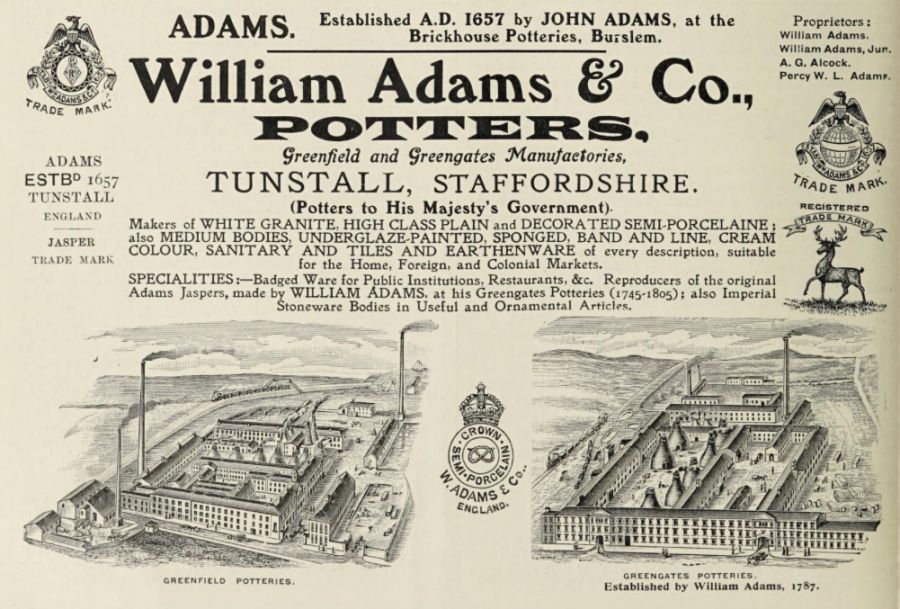
Adams. Established A.D. 1657 by
John Adams, at the Brickhouse Potteries, Burslem
William Adams & Co, Potters
Greenfield and Greengates Manufactories
Tunstall, Staffordshire
1906 advert from the Pottery Gazette and Trade Review
|
"William Adams & Co., Greenfield and Greengates Potteries, Tunstall, are one of the oldest firms in the Potteries. Their business having been established by John Adams so far back as 1657, is still in the hands of his descendants. Theirs is a many-sided business. They are manufacturers of white granite, high-class semi-porcelain, both plain and decorated, medium bodied ware, painted under glaze, sponged, band and line, sanitary ware, tiles, and general earthenware of practically every description for the home, foreign, and Colonial trades. Their semi-porcelain toilet and table ware is supplied in a variety of printed and enamelled decorations on a number of up-to-date shapes, and also on selected reproductions of their old-time forms. There is just now a preference for old styles, especially in toilet ware. These the firm are able to supply from their early moulds and ornamented with their early transfer decorations. They have a world-wide reputation for "Adams jaspers", made by William Adams from 1745 to 1805. The firm still have the original models designed by their eminent predecessor and famous modellers who worked with him. The jaspers they are supplying to-day are therefore not mere copies, they are veritable replicas of the original Adams jaspers, with classical and eighteenth-century subjects in white bas-relief on blue and other coloured grounds. These reproductions are not limited to ornamental vases, but include useful lines, such as jardinières, tea-pots, sugars and creams, candlesticks, trinket sets, biscuit jars, hot-water jugs, and other articles for the china dealer and the silver mounter. The "Florence" shape flower-pot — the centre piece of the upper row in our illustration — with the design of the Dancing Maidens in white relief, makes an attractive jardinière. The vases right and left of this are classical in form and ornamentation. The vase No. 313, on the left, with the "Seasons" design is a pleasing specimen. The figures representing the seasons are said to have been originally modelled by Adams himself, as were many others of the designs used at his factories. The colour of the blue is excellent, while the sharpness in detail of the figures and design in relief is remarkable. All the firm’s productions have the name impressed on the bottom. Messrs. Wm. Adams & Co. have for some time been supplying miniature pieces in loving cups, vases, and a number of small items in their famous Jasper, with the arms of towns and cities applied in white relief. These are useful for presents, and serve as excellent souvenirs for visitors, while the prices are moderate for high-class fabrics. Messrs. H. & M. Harris, 7, Buchanan-buildings, Holborn, E.C., are the firm’s London agents for this branch of their business, and they will be pleased to show buyers samples of the ware at any time." Editorial in the March 1906 Pottery Gazette |
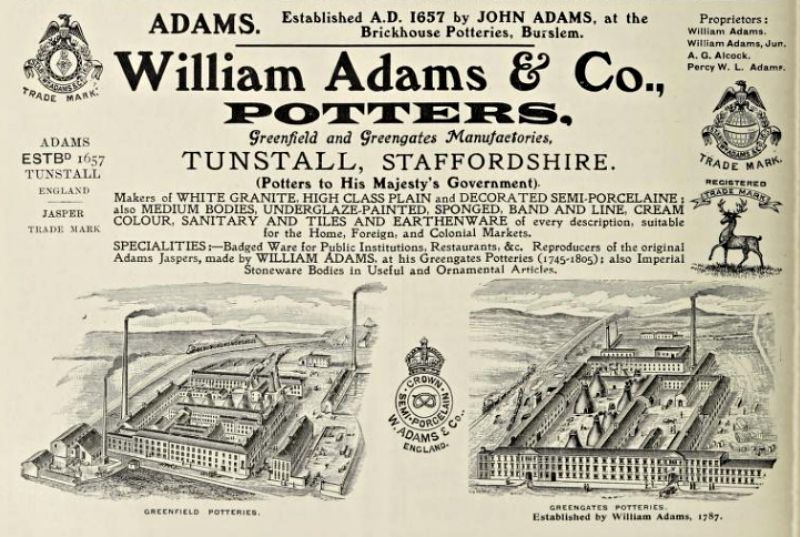
Established A.D. 157 by John
Adams at the Brickhouse Potteries, Burslem
William Adams & Co
Potters
Greenfield and Greengates
Manufactories
Tunstall, Staffordshire
(Potters to His Majesty's Government)
advert from the January 1906 Pottery Gazette and Trade Review
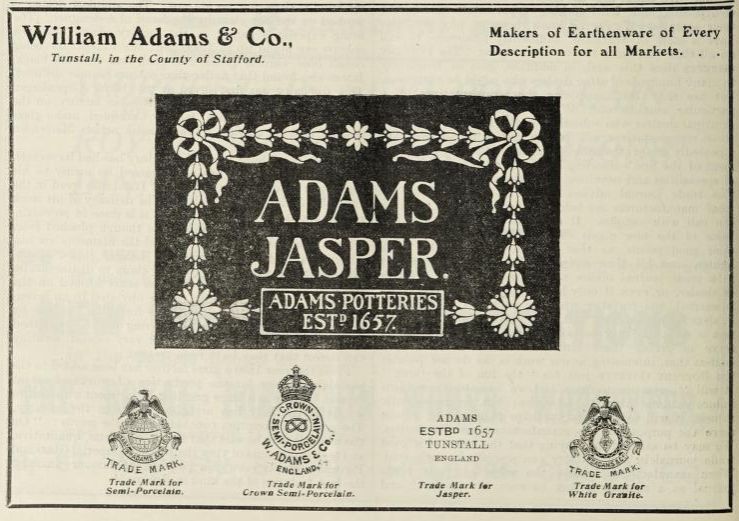
William Adams & Co.,
Tunstall, in the County of Stafford
Makers of Earthenware of Every Description for all Markets.
Adams Jasper
Adams Potteries
Estd 1657
advert from the November 1906 Pottery Gazette and Trade Review
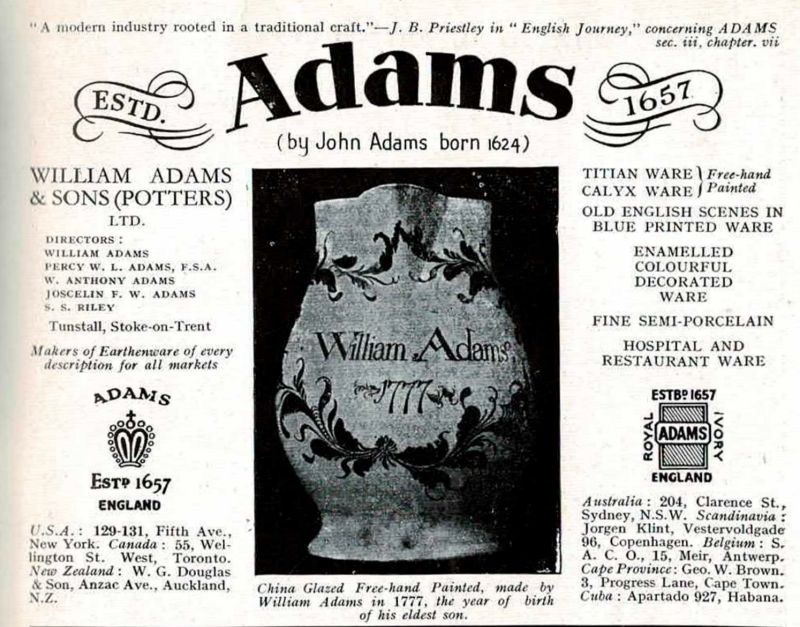
William Adams & Sons
(Potters) Ltd
advert from the 1951 Pottery Gazette and Trade Review Reference Book
American Historical Transferware Sheets
 |
Imported especially for: Jessie T. Matheson Provincetown, Mass W. Adams & Co. Estd 1657 England French, Mitchell, Woodbury Co., Boston |
|
From and antique scrap book consisting of 17 images of various American Landmarks which were produced as blue & white souvenir plates by William Adams & Co of Stoke-on-Trent, England and imported by French, Mitchell, Woodbury & Co of Boston, USA. - click for more details on the souvenir plates and transfers - |
|
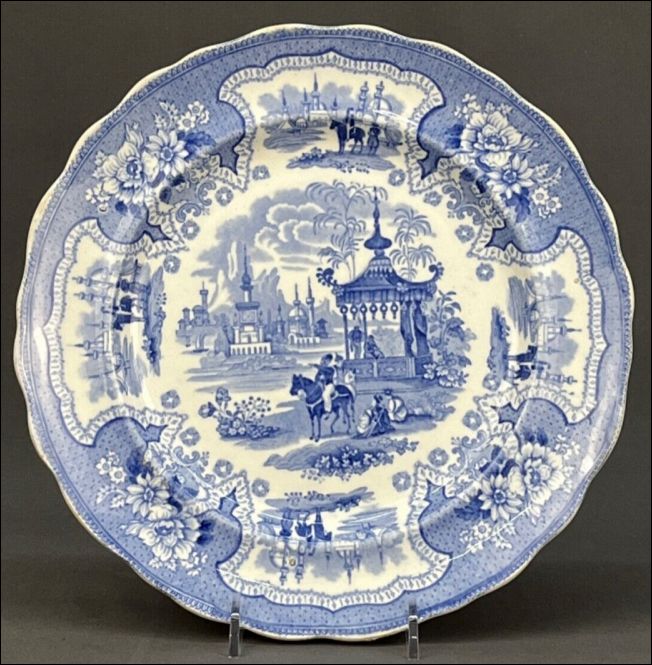 blue & white transfer ware plate in the Palestine pattern
|
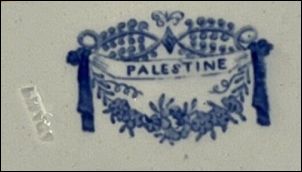 Palestine ADAMS
|
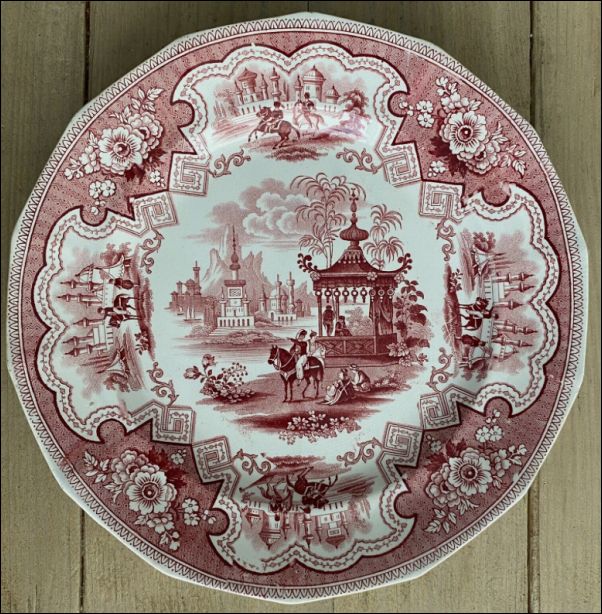 pink & white transfer ware plate in the Damascus pattern This same pattern was also produced by Adams under the name 'Palestine' - this does not appear to have been a mistake as a number of examples are known There are also examples with the scene
transposed with the |
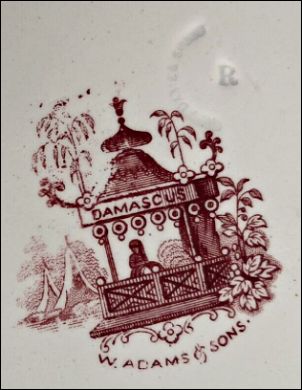 Damascus W. Adams & Sons impressed mark
|
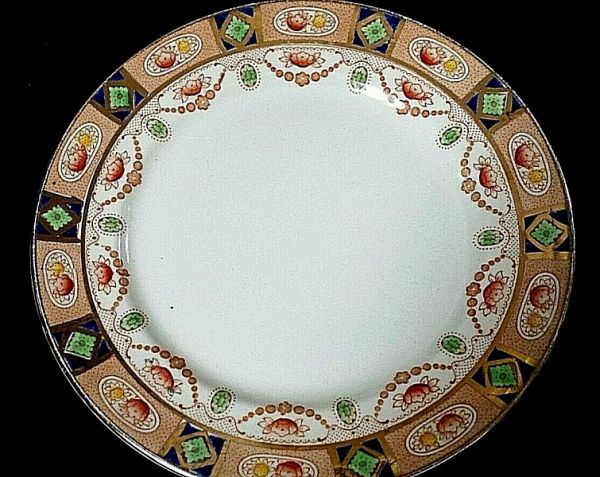 plate in the European Imari style |
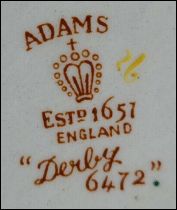 ADAMS Estd 1657 England the pattern name 'Derby' is probably
|
|
Jeddo Pattern: Jeddo
was used as a pattern name by J & M P Bell (Glasgow 1842-1928), Beech
& Hancock (Tunstall 1857-1876) and William Adams. Jeddo was an anglicised name for the Japanese port of Edo. After 1868, Edo was renamed as Tokyo. The names Jeddo and Yedo became commonly used by English-speaking people in the mid-1800s. During
its period of operation Adams produced at least three differing patterns with
the name Jeddo. |
| W.
Adams & Sons (1819-64) |
W.
Adams & Co (1891-into C20) |
Adams
- Member of the Wedgwood Group (1966-90s) |
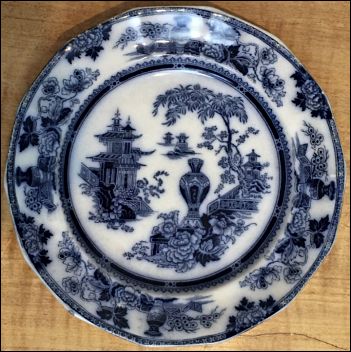 |
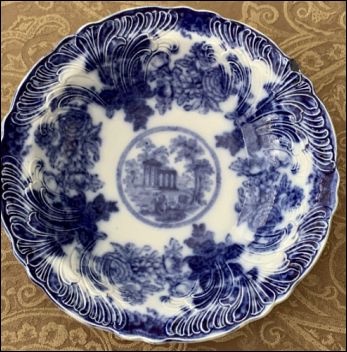 |
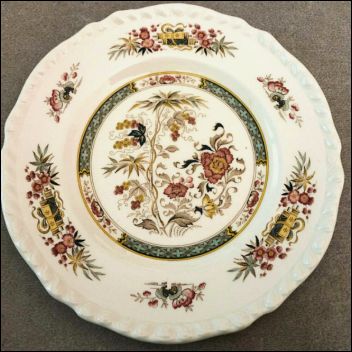 |
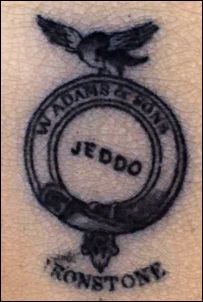 |
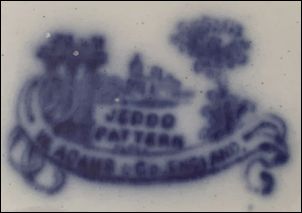 |
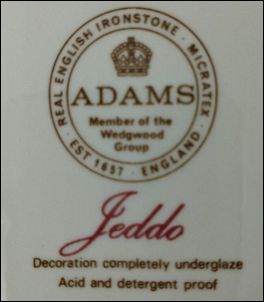 |
|
Calyx ware: Calyx ware was a trade name of William Adams & Sons. There is little or no information on the origins of the name. Originally Calyx ware appeared to be hand decorated ware. Later Calyx ware was hand coloured transfer patterns, all in a light pattern, often with pastel coloured blocks/bands. The name appears to have been introduced around 1930 and continued thought the operation of the Adams business. The name was continued after the 1966 take over by Wedgwood, the use of the name seems to have finished around 1975.
|
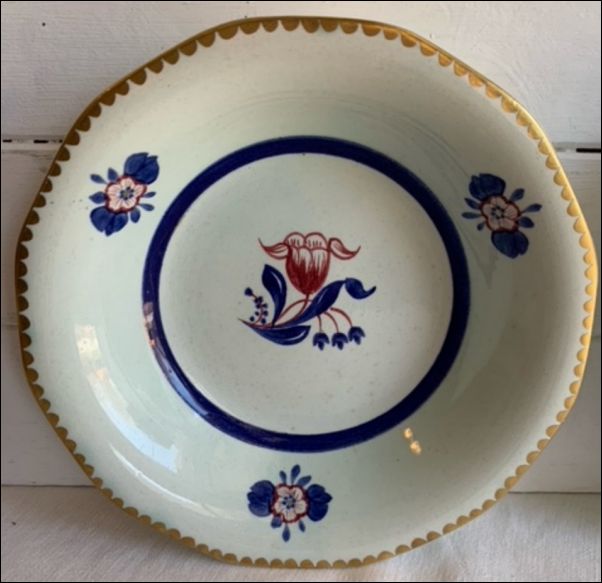 bowl in the Georgian Tulip pattern |
Calyx
Ware |
photos courtesy: Leslie Town
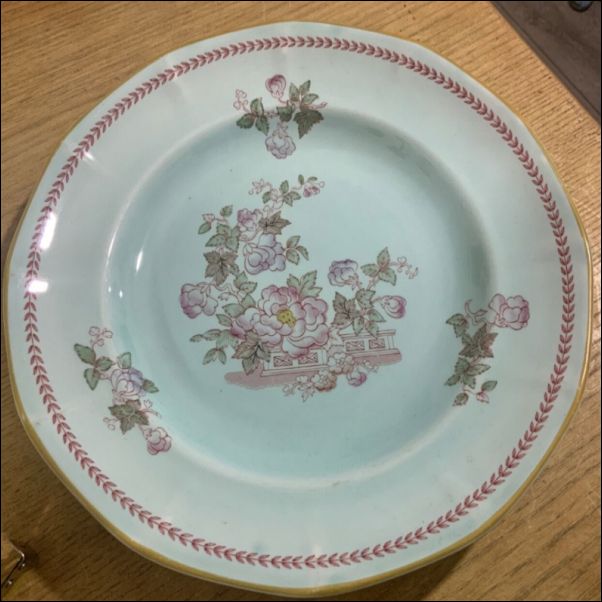 plate in the Metz pattern |
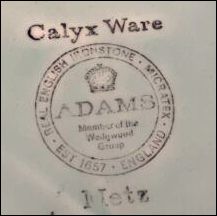 Calyx Ware Real English Ironstone Micratex Est 1657 England ADAMS |
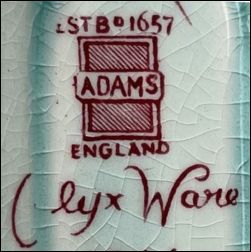 Estb 1657 ADAMS England Calyx Ware c. 1930-62 |
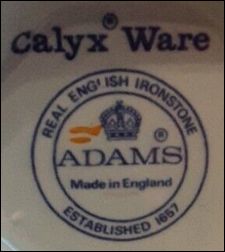 Calyx Ware Real English Ironstone ADAMS Made in England Established 1657 c. 1962+ |
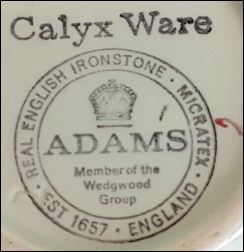 Calyx Ware Real English Ironstone Micratex Est 1657 England ADAMS c. 1966-75 |
Trade Names:
|
Titian ware: Titian ware was a trade name of William Adams & Sons. There is no known information on the origins of the name. The Titian Ware name always appears to be associated with the oblong 'Estd 1657' mark incorporating the words 'Royal Ivory' There is no clear evidence on the date the the name 'Titian Ware' was introduced:
|
TITIAN WARE
Royal Ivory
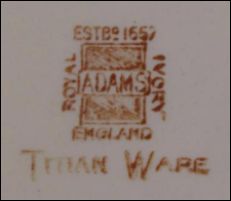 |
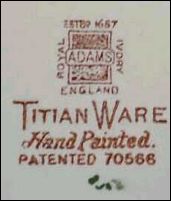 Patented 70566 |
the registration number is for a pattern registered in 1905 |
the registration number is for a pattern registered in 1929 |
CALYX WARE
(20thC trade name impressed or
incorporated in printed marks)
MICRATEX
(trade name for a new extra-strong body
introduced in 1963)
Style of name used on ware:
| ADAMS & CO | impressed mark, 1769-1800 |
| ADAMS | impressed mark, 1787-1805 on Jasper ware and 1800-1864 on general ware. |
| W. ADAMS & CO | impressed mark, c.1815 (rare impressed mark) |
| W. ADAMS & SONS W. A. & S |
names and initials used in several, different printed marks. Often the name of the pattern is included, 1819-64 |
| ADAMS | impressed mark found on figures and groups (parian) 1845-64 |
| W. ADAMS | names and initials used in several, different printed marks. Often the name of the pattern is included, mid 19th C |
| W. A. & CO | names and initials used in several, different printed marks. Often the name of the pattern is included, 1893-1917 |
Marks used on ware for identification:
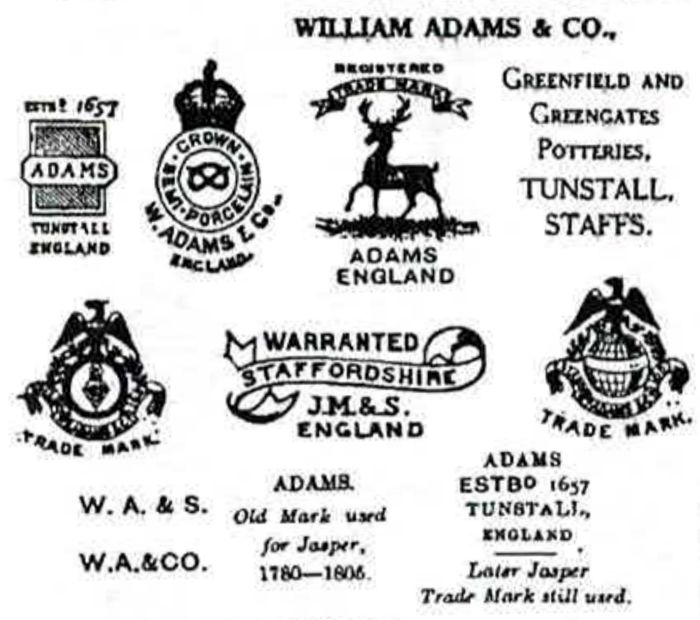
this table of marks was printed
in the 1917 Pottery Gazette
note:
the 'Warranted Staffordshire J.M. & S' mark is that of
John Meir & Son who operated at the
Adams' Greengate Pottery

Some Adams' marks incorporated a crown and
Stafford knot used
from c.1879 and into the early 20thC

- click forother
examples of marks used by Adams -
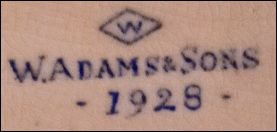 W W. Adams & Sons - 1928 - The ‘W’ within the diamond most likely relates to the products being commissioned and produced for the Office of Works (until 1939) |
George V the King of the United Kingdom (1919-36) |

G VI R
Adams
1942
|
The mark shown indicates that the ware was produced for and supplied to the British Government; it was ultimately property of the Crown/Government, hence the GR-VI Cypher. This mark is there to distinguish the piece from being normal ‘utilitarian’ ware for public sale during the period surrounding the Second World War. William Adams (and others) were given government contracts throughout the late 1930s and into the 1940s (WWII) and produced canteen ware - most likely for the armed services. The year of manufacturer is generally included. |
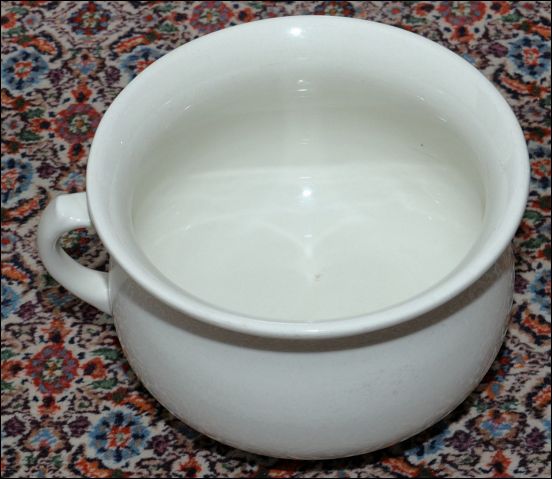 white ironstone chamber pot - likely for issue to the armed forces |
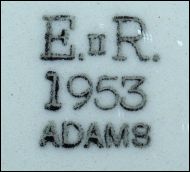 E II R 1953 Adams |
photos courtesy: Roland Weilguny
![]() History of Adams family of Potters
History of Adams family of Potters
Questions, comments, contributions? email: Steve Birks
|
Page created 2 March 2008 Last updated: 26 Sept 2005 - details of Titian ware & marks added, January 1906 advert added |